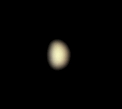
iPhone 5s: Mercury, Jupiter, Mars, Moon
Posted: 14 May 2014
|
Opened: Tuesday, 13 May 2014, 1831 MST Temperature: 83°F |
Session: 684 Conditions: Clear, breezy |
1839 MST: viewed Mercury, low in the west, 83X and 222X. A nearly half-phase was visible. Tried some iPhone 5s afocal slo-mo (120 fps) video recordings at 666X even though seeing was not very good. This is a stack of 1100 frames at 1847 MST:

1855 MST: viewed Jupiter, 666X. Then began waiting for sunset. 1910 MST: the breezes were getting stronger. 1918 MST: sunset. Saw the "green flash".
Tried some iPhone afocal slo-mo video recordings of Jupiter at 666X. The wind was strong at times, causing some telescope movement during the video recordings. This is a stack of 6057 frames taken at 1920 MST:

1927 MST: Resumed Jupiter observing, 222X. Three moons were visible.
Then slewed to Mars for viewing at 222X. The North Polar Cap and possibly a sunrise cloud near the equator were all that were visible. Switched to 666X; seeing was not very good, but decided to try some imaging anyway since the wind was forecast to increase as the night proceeded. This is a stack of 7126 frames using one of the Variable Polarizing filters, taken at 1944 MST:

1952 MST: resumed Mars observing, 222X. Still no dark surface areas visible to the eye (although one does appear faintly in the processed image above). Did a quick collimation check on the star Spica, 222X; it was OK. Returned to Mars and did some more observing. Never saw any dark areas this night.
1957 MST: still very breezy. Saturn had just risen above the hill to the southeast. The nearly full moon was already up but behind a tree. 2020 MST: breezes even stronger now. Seeing at Mars was worsening.
2029 MST: viewed the moon just coming out from behind the tree, 222X. Slight terminator visible about 16 hours prior to being precisely Full phase. Grabbed this quick handheld iPhone afocal 83X photo:

Could not quite capture the entire lunar disk, but due to the wind and poor seeing, didn't bother to reduce the magnification.
2038 MST: took a quick look at Saturn through the tree branches, 83X. Then began closing up for the night due to the wind.
|
Closed: Tuesday, 13 May 2014, 2048 MST Temperature: 66°F |
|
Comments are welcome using Email. If you are on Twitter you can use the button below to tweet this report to your followers. Thanks.
Cassiopeia Observatory Home Page